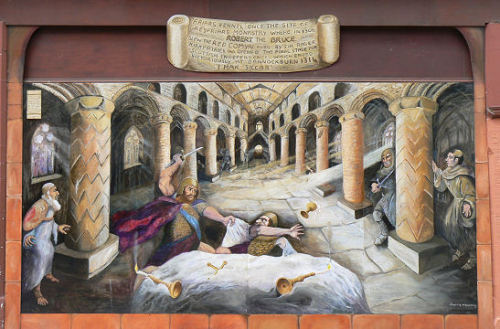Robert the Bruce, The Rebel King, Part I — The Murder of John Comyn.The start of the 14th cent
Robert the Bruce, The Rebel King, Part I — The Murder of John Comyn.The start of the 14th century was a tumultuous time for Scotland. In 1298 the King of Scotland, John Balliol, had abdicated his throne after the defeat of William Wallace by the English. Not that it really mattered, as Balliol was merely a puppet king under the control of King Edward I Longshanks. He didn’t even live in Scotland, spending most of his reign living at a quiet estate in France. England controlled Scotland, enforcing its own laws and taxes upon the country. Worse yet it was hard to call Scotland a country to begin with, as differences between hotheaded nobles, Scottish lowlanders, and Gaelic speaking highlanders threatened to dis-unify the nation. Scots spent more time fighting each other rather than fighting the English.The only thing that gave Scotland any semblance of a unified kingdom was the Scottish King. In the early 1300’s the Bishop of Scotland began to secretly organize something very ambitious, the restoration of the Scottish monarchy. At the time, the there were two claimants to the throne; Robert the Bruce and John Comyn. Both had pretty good claims and both sought the throne passionately. In any other kingdom such a situation typically led to civil war, however there was no time for infighting. What would happen next would decide the destiny of Scotland.In 1306 Robert the Bruce and John Comyn, at the behest of the Bishop of Scotland, agreed to a secret meeting at Greyfriars Kirk at Dumfries. The two left their swords at the door, embraced, and entered the church alone in hope of negotiating a deal. It is unknown what was said during the meeting or what occurred during the negotiations. However it is known that Robert the Bruce and John Comyn engaged in a heated argument. In the end, Robert the Bruce drew a dagger and stabbed John Comyn to death at the alter. A short time later he learned that John Comyn was not dead. He sent his friend Roger de Kirkpatrick back into the church to finish him off.Unlike what is depicted in movies or TV, cold blooded killers typically are not chosen as king. It’s pretty bad form to have a murderer as head of state. Robert the Bruce faced disaster and ruin, as he could not only be declared an outlaw and lose his right to the Scottish throne, but be damned to hell for spilling blood in the house of God. The Bruce fled to Glasgow Cathedral to meet with the Bishop of Scotland. The Bishop could have easily disavowed the Bruce’s claim to the throne, however there was too much at stake, and both the Bishop and Scotland were in too deep. At this point, there was no turning back. The Bishop absolved the Bruce of all blood guilt (although he was excommunicated by the Pope, it would be lifted in 1328). He then launched the Bruce as the sole candidate for King. After gaining support from a number of Scottish nobles, Robert the Bruce was declared King six weeks after the death of John Comyn.When King Edward Longshanks of England received word that a new Scottish king had been crowned, he immediately organized an army to crush Robert the Bruce’s rebellion. The Bruce himself managed to build an army of 4,500 men from his supporters and allies. Bruce believed that the English would fight a gentlemanly battle, which he would win, and that the war would be over, securing Scottish independence. Robert the Bruce’s naive belief in a quick victory would nearly end his monarchy before it even began, and prove the crown on his brow to be very costly.To be continued… -- source link
Tumblr Blog : peashooter85.tumblr.com
#history#scottish history#scotland#monarchs#kings#john comyn#murder

